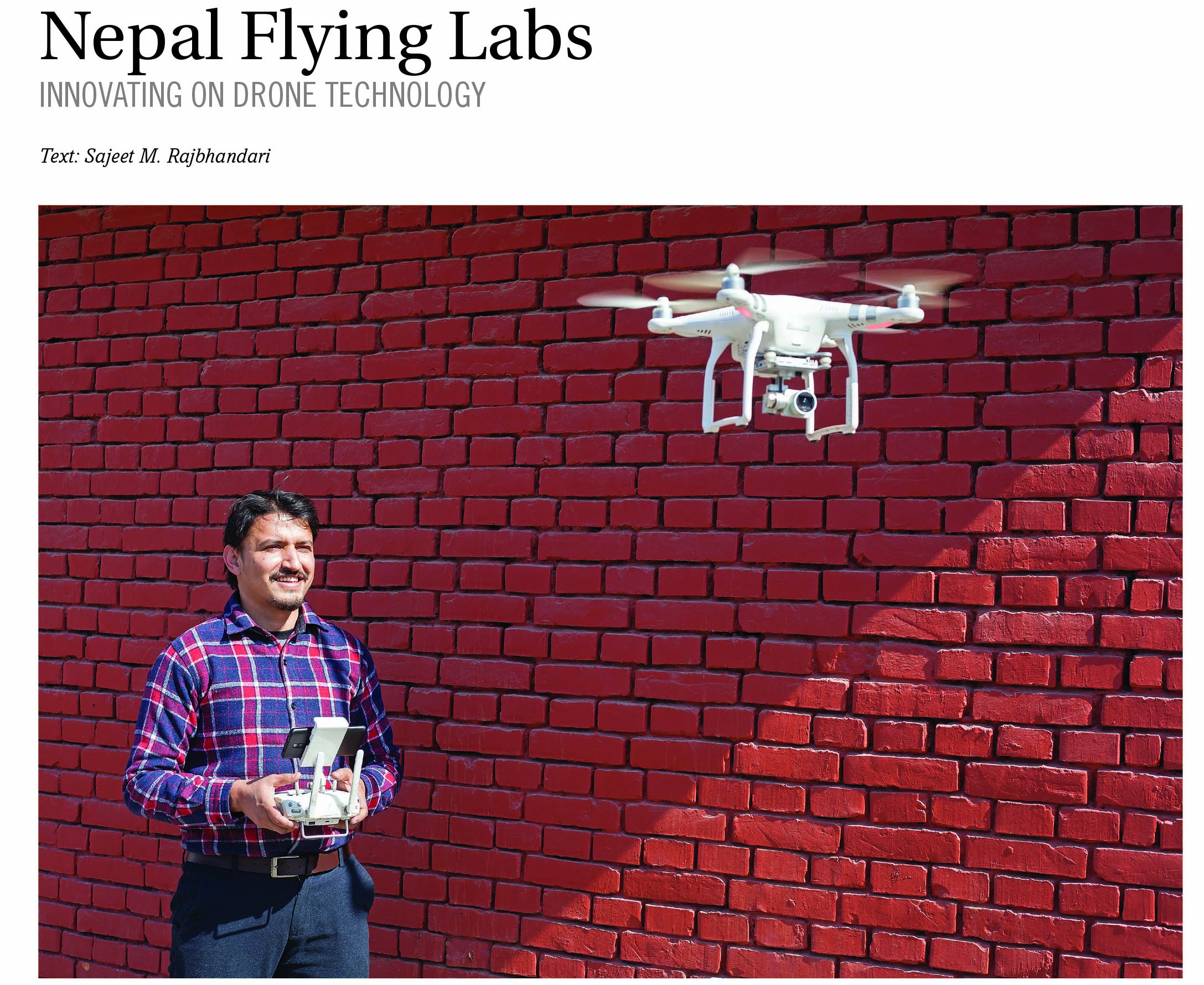
The world we live in today has grown to become dramatically different than the world we used to live in a decade ago. Be it for better or worse, technological innovations have changed the way we perceive and interact with the world around us. From ordering food from your favourite restaurant online to relying on algorithms for your next Netflix binge, technology has moved leaps and bounds over the last few decades. Not only have scientific innovations gotten more intriguing, these innovations have also managed to trickle down all the way to everyday consumer appliances that the average person uses. Amongst the vast archives of technological innovations that have come up, one piece of technological marvel that stands out is Drones. Early recollections of drones include seeing Hollywood interpretations of them in over-the-top spy flicks. Now it seems that drones are no longer limited to 007’s arsenal; from children’s toys to videography tools has found fascination among a wide range of consumers. But the truth is drone tech is not just a fun recreational gadget and people still have a limited idea of what drones are really capable of. While fancy videos of beautiful skylines are exhilarating to see, a great deal of the potential that drone tech carries has been left unexplored. This is where Nepal Flying Labs comes in and diverges from the perception that most people have about the world flying robots. The original idea for Nepal Flying Labs was an unlikely outcome of a national tragedy. The 2015 Nepal earthquake was a day of reckoning for many across the country. Not only did it result in unimaginable death tolls, it also highlighted how unprepared we were for crisis situations like the earthquake. Once the dust from the earthquake started to settle, people started to look for solutions to improve the disaster response and disaster analysis systems in the country. This search led to a training program held at Kathmandu University that focused on adapting and engineering drone technology in a way that would assist in crisis management. Institutes such as WeRobotics, DJI, and Pix4D arrived in a torn Nepal to deliver and discuss how drone tech could be used for crisis mapping. Amongst the numerous academics and innovators that joined the program, Uttam Pudasaini, the current Executive Director of Nepal Flying Labs, was present. For Pudasaini, who had also done his engineering thesis on “Drone Mapping”, the training presented the ideal circumstance and networking opportunity where he could envision how drones and artificial intelligence could be used for greater social good.
During the training, Pudasaini along with WeRobotics came to the realisation that a singular training program would not suffice for the proper inculcation of a complex technology like drones in Nepal. In Pudasaini’s words, “Normally during a crisis, various international organisations come, provide trainings, and then disappear. But in this particular moment, we realised that for any developing country or a country at risk, a one-time training is not a sustainable approach for the introduction of new-frontier technologies like this. Rather, there needs to be a local entity that drives these activities forward.” This vision resulted in the creation of Nepal Flying Labs, a non-profit company that has made its mission to incubate and expand social-tech entrepreneurships pertaining to drones in Nepal. Pudasaini shares that unlike other non-profits that focused on specific projects at a time, Nepal Flying Labs aims to establish a proper ecosystem for drone use in Nepal. To achieve this, he realised that they needed to gather more people in Nepal who could assist in establishing drone services in Nepal. Nepal Flying Labs then initiated a business incubation venture that would not only allow them to network and connect with like-minded drone enthusiasts but also allow Nepal Flying Labs to assist and promote start-ups that utilised drone technology. Pudasaini reaffirms that the goal for Nepal Flying Labs is not to be a big company by itself but rather act as an enabler that promotes drone services in Nepal. When it comes to the actual team, Nepal Flying Labs hires people on a project basis. This could range from normal administrative staff to specialised drone pilots that are capable of operating the company’s delicate equipment. With the Nepal Flying Labs team and network in place, Pudasaini and his team sought to achieve three targets in particular: Create an ecosystem for drones in Nepal; Promote positives of drone tech in Nepal; Solve local problems through capacity building for drones. While these are the targets for Nepal, Pudasaini says that the idea of Flying Labs is not limited to Nepal. He shares, “Flying Labs is a brand that can happen in any country. It just so happened to start its journey in Nepal.” In fact, up until the time of writing, Flying Labs exists in over 30 different countries spread across Asia, Africa, Latin America and Europe. Even within the world of drones, there exists a vast array of specialised technologies and an even wider number of possible applications. Drones can take up different form factors and a specific type of drone is built around a specific mindset. So what technologies does Nepal Flying Lab have under its tool belt, and how have they made use of it? One of the key works that Nepal Flying Labs has been doing is to use drones to make high-resolution maps of different locations within Nepal. “There is a perception that drones are a flying camera. Just like beautiful photos and videos, we have used drones to create beautiful maps as well,” claims Pudasaini. These high-resolution maps can then be utilised for multiple purposes. Take for instance, the construction of roads in a rural area with tricky geography. Pudasaini claims that with mapping drones, constructors can avoid having to take the risks of travelling to risky uncharted grounds without any factual assessment. The same mapping drones can also be equally as effective during crisis situations. Pudasaini explains, “During the 2015 earthquake, the army and other responders in Bhaktapur were having a tough time figuring out where they were needed and where they were not. With drones, emergency responders could be placed on standby while drones are launched which would give them better situational awareness. It could have shown how the debris was spread and where the victims were seeking help.” Moreover, Pudasaini says that drones can also be equipped with specialised gears such as thermal or infra-red cameras that further assist the survey process.
As a result, drones are not just meant for large disasters like the 2015 earthquake but also for ones that are more commonplace like landslides and floods.To further aid the use of drones during a crisis, Nepal Flying Labs also provide disaster simulation trainings. But besides geographical mapping, Nepal Flying Labs has been optimising drone tech to serve as cargo carriers; specifically medical cargo. Started as a pilot project in Pyuthan almost two years back, Nepal Flying Labs has been working as a connecting link between rural health posts and central hospitals in the district. The project which has a functioning range of around seven kilometers, has allowed medical workers to rapidly collect sputum that allows them to effectively diagnose tuberculosis patients in rural villages without having to waste precious time and resource. This work done by Nepal Flying Labs did not go unnoticed. Also known as the Drone Optimized Therapy System (DrOTS), the pilot project won the coveted TIACA air cargo award and the AUVSI humanitarian innovation award for 2020. In the matter of the bigger picture, Flying Labs along with WeRobotics have acquired numerous grants from notable institutions such as Pfizer and the Gates Foundation to further develop their medical cargo drones. As for technical infrastructure that is needed to run these projects, Pudasaini shares that they have mostly been making the commercially available drones that the average consumer can buy. Pudasaini suggests that for tasks such as mapping, it is less dependent on the complexity of the equipment and more on the technical knowhow of the team heading the project. Here, a lot of the nitty-gritty of the task lies in the compilation, presentation and analysis of the data that their small four-rotor drones collect. Even larger scale mapping projects utilise fixed winged drones that resemble planes rather than helicopters. As for cargo projects like that in Pyuthan, Nepal Flying Labs has been running customised variants of commercial hexa-copter drones such as the DJI M600. Pudasini shares, “Normally, these drones are meant to carry bigger cameras for things like videography, but what WeRobotics has done is that instead of something like a camera, we modified it to carry something like a hefty cargo box.” However, these cargo carrying drones that were customised by WeRobotics were not the end of the assembly line. While the modifications that WeRobotics made were certainly a gift to Nepal Flying Labs for its medical cargo projects, Nepal’s harsh and unforgiving topography pushed them to innovate further. “Nepal’s complex topography created a big problem for the automated landing systems that have been built into these drones.” The inventive solution that the team came up was to create a whole new “precision landing system.” While the technical jargon might make it seem daunting at the first glance, it is the ingenious simplicity of Nepal Flying Lab’s “precision landing system” that really takes the crown. “We had local tailors of the rural village sew a piece of cloth that was almost 1.5m x 1.5m. On the cloth we designed a particular pattern. Now what this does is, when the drone arrives at the health post from the hospital, it uses its camera to identify and follow the pattern on the ground to make the perfect landing,” explains Pudasaini. The work that Nepal Flying Labs has been doing is certainly making huge strides in furthering drone-based services in Nepal, but there is still a long way to go. Despite having an expansive range of applications, drones if left unregulated, can also result in equally disastrous situations. From major risks such as surveillance and terrorism, to dangers such as haphazard air traffic are things that anyone using drones should take into account. For now, it seems that the cons to drone tech equal the pros that it carries.
Pudasaini states, “People in urban areas take drones too casually. I am strongly against this sentiment, because while drones are easy to learn, if not controlled properly, it can also result in big disasters. This is why while Nepal does need to promote drones it should only be done in a proper and well-regulated manner.” In fact, Nepal Flying Labs has been taking steps to ensure a more holistic development of the drone ecosystem in Nepal. Internationally, the entire Flying Labs project has come up with a code of conduct that has been approved by over 80 humanitarian organisations. These codes dictate important guidelines that every drone mission needs to abide by from safety technicalities to maintaining data privacy. As for the national level, Nepal Flying Labs has been working hand-in-hand with government entities to create levelheaded and well researched drone regulations. This even includes a web application that when in operation will digitally simplify the permission granting process for drones to use airspace. In regard to the future of Nepal Flying Labs, Pudasaini reaffirms the company’s dedication to becoming an enabler for drone-service startups in Nepal. This even includes plans to become an entity that can provide certified professional grade piloting programs that will ultimately help with the licensing and regulation of drones.
However, Nepal Flying Lab’s plan for drones is not limited to just the skies, in fact the team has already been looking into aquatic drones that might help better track Himalayan glacier systems and help aid crucial environmental research. Pudasaini and Nepal Flying Labs believe that drones are the future of transportation, and that they are bound to influence our lives in one way or the other. These intricate and nimble machines provide us with development and emergency measures that would have otherwise been unprecedented before. At the same time, Nepal Flying Labs also acknowledges the risks that drones pose and advocates for the proper regulation of these new and uncharted forms of technology.






-1747384393.jpg)